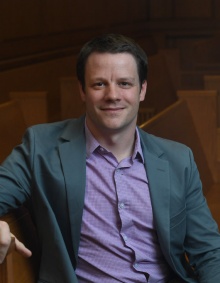Making sense of law, by the numbers

Associate Professor Clayton Masterman’s background in economics offers a unique perspective in examining how our legal system functions.
Masterman studied economics and mathematics at Vassar College, but ever since his time on the high school debate team he knew his life’s trajectory was headed toward the law. It was in his junior year at Vassar that he took a course in Law and Economics, discovering that the analytical tools of economic study can readily be applied to questions of law.
“It’s about taking the tools of economic analysis, mathematical modeling of human decision making and rigorous statistical analysis, and applying those techniques to investigating how the law should work,” he says.
He went on to Vanderbilt University and that school’s joint JD and PhD program which enabled him to earn both degrees in six years. He served as articles editor of the Vanderbilt Law Review and, in the doctoral program in law and economics, wrote his dissertation on public policy responses to the opioid epidemic. It was a subject that hit home for him, he says, as a native of Golden Valley, Ariz., a textbook example of so many small rural communities that have been affected by opioid addiction.
At UB Law, Masterman is teaching Torts, a broad subject which he notes includes lawsuits ranging from small personal injury suits to mass litigation against opioid manufacturers. He notes that Law and Economics has influenced tort law, including by shaping what it means to be negligent or to take enough care under specific circumstances. One famous example he cites: United States v. Carroll Towing Co., a 1947 decision in the federal Second Circuit Court of Appeals that used a mathematical formula to establish a balancing test for whether negligence had occurred. (The case involved a barge that had sunk in New York Harbor after a mooring line came loose; the judge, the famous Learned Hand, used algebraic notation to render his formula for evaluating negligence.)
He also brings to the classroom the practical wisdom of two year-long clerkships for federal Court of Appeals judges, in Houston and in Washington, D.C., as well as experience in practice with the boutique D.C. law firm Kellogg, Hansen, Todd, Figel & Frederick, where he worked on litigation cases involving intellectual property, antitrust and securities.
“Most of the students I teach will not become professors,” Masterman says, “so the experience of having seen the courts in action is helpful.” The clerkships especially, he says, were formative: “It’s an opportunity to see how the courts really work from the inside and see how folks who have had a more traditional legal career see the world. I learned a lot about how judges think, and I was really privileged to work for two judges who were very interested and invested mentors.”
It’s a twist of fate that Masterman, who considered majoring in political science as an undergraduate but didn’t love the writing involved, now finds himself an active and productive scholar as well as teacher. He has continued to explore the legal implications of public policy around opioid abuse, and has written and presented on the public health sector’s response to the COVID-19 pandemic.
In a recently submitted article, for example, Masterman looks at individual states that have passed laws immunizing health care providers, business owners and manufacturers of protective equipment against tort claims for spreading the virus. “I wanted to investigate what effect those laws actually had, and how they affected the spread of COVID in communities,” he says.
“I found evidence that these laws incentivized health care providers to admit more patients to hospitals but didn’t do much to improve outcomes. And I found that laws that immunized businesses from liability seemed to decrease the number of cases that spread in the community, maybe because they made it easier for businesses to institute requirements that their customers adhere to public health guidelines.”